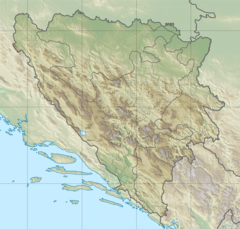
Alija Izetbegović was a Bosnian politician, Islamic philosopher and author, who in 1992 became the first president of the Presidency of the newly independent Republic of Bosnia and Herzegovina. He later served as the first chairman of the Presidency of Bosnia and Herzegovina.

Naser Orić is a Bosnian former officer who commanded Army of the Republic of Bosnia and Herzegovina (ARBiH) forces in the Srebrenica enclave in eastern Bosnia surrounded by Bosnian Serb forces, during the Bosnian War.

The Herzegovina-Neretva Canton is one of 10 cantons of the Federation of Bosnia and Herzegovina in Bosnia and Herzegovina.

Foča is a town and municipality of south-eastern Bosnia and Herzegovina, located in the Republika Srpska entity on the banks of Drina river. As of 2013, the town has a population of 12,234 inhabitants, while the municipality has 18,288 inhabitants. Foča houses some faculties from the Istočno Sarajevo University. It is also home to the "Seminary of Saint Peter of Sarajevo and Dabar-Bosna", one of seven seminaries in the Serbian Orthodox Church. Foča was also, until 1992, home to one of Bosnia's most important Islamic high schools, the Madrasa of Mehmed Pasha Kukavica. The Sutjeska National Park, which is the oldest National Park in Bosnia and Herzegovina, is located in the municipality.

The Bosnian War was an international armed conflict that took place in Bosnia and Herzegovina between 1992 and 1995. The war is commonly seen as having started on 6 April 1992, following several earlier violent incidents. It ended on 14 December 1995 when the Dayton Accords were signed. The main belligerents were the forces of the Republic of Bosnia and Herzegovina, the Republic of Herzeg-Bosnia, and the Republika Srpska, the latter two entities being proto-states led and supplied by Croatia and Serbia, respectively.

The Čelebići camp was a prison camp run by joint Bosniak and Bosnian Croat forces during the Bosnian War where Serb prisoners were detained and subjected to murder, beatings, torture, sexual assaults and otherwise cruel and inhumane treatment. The facility was used by several units of the Bosnian Ministry of the Interior (MUP), Croatian Defence Council (HVO) and later the Bosnian Territorial Defence Forces (TO). It was located in Čelebići, a village in the central Bosnian municipality of Konjic.
Hazim Delić is a Bosnian former prison camp commander who served as the deputy commander of the Čelebići camp, a joint Bosniak and Bosnian Croat forces run prison camp, during the Bosnian War. The majority of the prisoners who were detained in the camp were men, captured during and after the military operations at Bradina and Donje Selo and their surrounding areas.

The Croat–Bosniak War was a conflict between the internationally recognized Republic of Bosnia and Herzegovina and the so-called Croatian Republic of Herzeg-Bosnia, supported by Croatia, that lasted from 18 October 1992 to 23 February 1994. It is often referred to as a "war within a war" because it was part of the larger Bosnian War. In the beginning, the Army of the Republic of Bosnia and Herzegovina and the Croatian Defence Council (HVO) fought together in an alliance against the Yugoslav People's Army (JNA) and the Army of Republika Srpska (VRS). By the end of 1992, however, tensions between the Army of the Republic of Bosnia and Herzegovina and the Croatian Defence Council increased. The first armed incidents between them occurred in October 1992 in central Bosnia. The military alliance continued until early 1993, when it mostly fell apart and the two former allies engaged in open conflict.

Konjic is a city located in the Herzegovina-Neretva Canton of the Federation of Bosnia and Herzegovina, one of two entities that make up Bosnia and Herzegovina. It is located in northern Herzegovina, around 60 kilometres (37 mi) southwest of Sarajevo, in a mountainous, heavily wooded area, and is 268 m (879 ft) above sea level. The municipality extends on both sides of the Neretva River. According to the 2013 census, the city of Konjic has a population of 10,732 inhabitants, whereas the municipality has 25,148.

The Croat–Bosniak War was a conflict between the Republic of Bosnia and Herzegovina and the Croatian Community of Herzeg-Bosnia, supported by Croatia, that lasted from 19 June 1992 – 23 February 1994. The Croat-Bosniak War is often referred to as a "war within a war" because it was part of the larger Bosnian War.
Trusina is a village in the municipality of Konjic, Bosnia and Herzegovina.

Bradina is a village in the municipality of Konjic in Herzegovina, Federation of Bosnia and Herzegovina, Bosnia and Herzegovina.

Ethnic cleansing occurred during the Bosnian War (1992–95) as large numbers of Bosnian Muslims (Bosniaks) and Bosnian Croats were forced to flee their homes or were expelled by the Army of Republika Srpska and Serb paramilitaries. Bosniaks and Bosnian Serbs had also been forced to flee or were expelled by Bosnian Croat forces, though on a restricted scale and in lesser numbers. The UN Security Council Final Report (1994) states while Bosniaks also engaged in "grave breaches of the Geneva Conventions and other violations of international humanitarian law", they "have not engaged in "systematic ethnic cleansing"". According to the report, "there is no factual basis for arguing that there is a 'moral equivalence' between the warring factions".

The siege of Mostar was fought during the Bosnian War first in 1992 and then again later in 1993 to 1994. Initially lasting between April 1992 and June 1992, it involved the Croatian Defence Council (HVO) and the Army of the Republic of Bosnia and Herzegovina (ARBiH) fighting against the Serb-dominated Yugoslav People's Army (JNA) after Bosnia and Herzegovina declared its independence from Yugoslavia. That phase ended in June 1992 after the success of Operation Jackal, launched by the Croatian Army (HV) and HVO. As a result of the first siege around 90,000 residents of Mostar fled and numerous religious buildings, cultural institutions, and bridges were damaged or destroyed.
Rodoč is a populated settlement in the Mostar municipality, just south of the city of Mostar, making it a suburb. It is 5 km (3.1 mi) from Mostar, 139 km (86 mi) from Sarajevo, 139 km (86 mi) from Dubrovnik and 157 km (98 mi) from Split.
Gornja Jošanica massacre was the mass murder in the village of Gornja Jošanica, near Foča in eastern Bosnia, where 56 Bosnian Serb civilians were killed during an attack by the Army of the Republic of Bosnia and Herzegovina (ARBiH) from 19 December 1992, on St. Nicolas Day.

Vrapčići is a suburban neighborhood in the City of Mostar, Bosnia and Herzegovina. It is part of the Northern metropolitan area.
The Musala camp was a prison camp in Konjic, Bosnia and Herzegovina operated by the Army of the Republic of Bosnia and Herzegovina (ARBiH) that was used to detain Bosnian Serbs and Bosnian Croats.
Esad Landžo is a Bosnian convicted war criminal and former camp guard at the Čelebići camp during the Bosnian War. He served under this capacity from the camp's establishment until it ceased operations, between May 1992 and December 1992, under the command of the camp's deputy commander Hazim Delić and commander Zdravko Mucić. As a guard, Landžo beat, tortured and murdered Serb prisoners.













